多吡啶配体及其铜铁配合物的合成与表征
- 格式:doc
- 大小:316.50 KB
- 文档页数:4
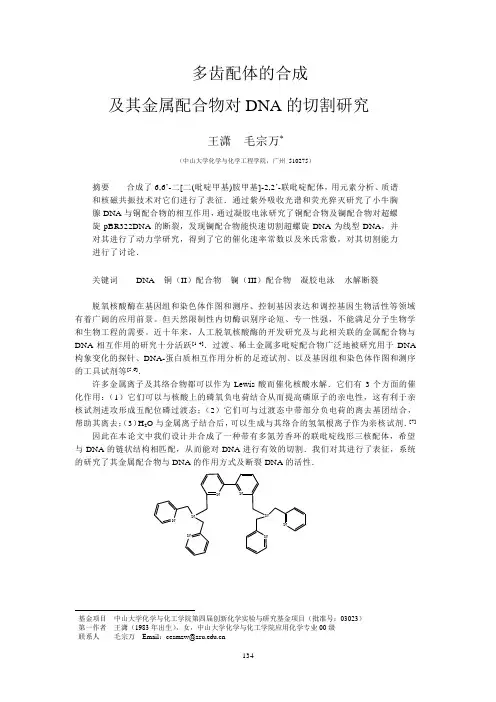
多齿配体的合成及其金属配合物对DNA 的切割研究王潇 毛宗万*(中山大学化学与化学工程学院,广州 510275)摘要 合成了6,6’-二[二(吡啶甲基)胺甲基]-2,2’-联吡啶配体,用元素分析、质谱和核磁共振技术对它们进行了表征.通过紫外吸收光谱和荧光猝灭研究了小牛胸腺DNA 与铜配合物的相互作用,通过凝胶电泳研究了铜配合物及镧配合物对超螺旋pBR322DNA 的断裂,发现镧配合物能快速切割超螺旋DNA 为线型DNA ,并对其进行了动力学研究,得到了它的催化速率常数以及米氏常数,对其切割能力进行了讨论.关键词 DNA 铜(II )配合物 镧(III )配合物 凝胶电泳 水解断裂脱氧核酸酶在基因组和染色体作图和测序、控制基因表达和调控基因生物活性等领域有着广阔的应用前景。
但天然限制性内切酶识别序论短、专一性强,不能满足分子生物学和生物工程的需要。
近十年来,人工脱氧核酸酶的开发研究及与此相关联的金属配合物与DNA 相互作用的研究十分活跃[1-4].过渡、稀土金属多吡啶配合物广泛地被研究用于DNA 构象变化的探针、DNA-蛋白质相互作用分析的足迹试剂、以及基因组和染色体作图和测序的工具试剂等[5,6].许多金属离子及其络合物都可以作为Lewis 酸而催化核酸水解.它们有3个方面的催化作用:(1)它们可以与核酸上的磷氧负电荷结合从而提高磷原子的亲电性,这有利于亲核试剂进攻形成五配位磷过渡态;(2)它们可与过渡态中带部分负电荷的离去基团结合,帮助其离去;(3)H 2O 与金属离子结合后,可以生成与其络合的氢氧根离子作为亲核试剂.[7] 因此在本论文中我们设计并合成了一种带有多氮芳香环的联吡啶线形三核配体,希望与DNA 的链状结构相匹配,从而能对DNA 进行有效的切割.我们对其进行了表征,系统的研究了其金属配合物与DNA 的作用方式及断裂DNA 的活性. N N N N NN N N基金项目 中山大学化学与化工学院第四届创新化学实验与研究基金项目(批准号:03023) 第一作者 王潇(1983年出生),女,中山大学化学与化工学院应用化学专业00级联系人 毛宗万 Email :cesmzw@1 实验部分合成1. 1 仪器与试剂德国Elementar公司VarioEL元素分析仪,美国Thermo Finnigan公司LCQ DECA XP 液相色谱-质谱联用仪(配备ESI和APCI),美国VARLAN公司CAY100紫外可见分光光度计,Varian INOVA核磁共振仪(500MHz)美国,北京市六一仪器厂电脑三恒多用电泳仪(DYY-12型).小牛胸腺DNA(CT DNA)购自华美公司,pBR322DNA,三羟甲基氨基甲烷(Tris),N-2-羟乙基哌嗪-N’-2-乙磺酸钠(HEPES Sodium Salt),乙二胺四乙酸二钠盐(EDTA Disodium Salt),购自上海生工公司,二(2-吡啶甲基)胺,6,6’-二甲基-2,2’-联吡啶,购自Aldrich公司.其它试剂均为分析纯.实验用水均为去离子重蒸水.1. 2 6,6’-二溴甲基-2,2’-联吡啶的合成[8]称取6,6’-二甲基-2,2’-联吡啶1.000g(5mmol),N-溴代丁二酰亚胺1.932g(10mmol)至100ml圆底烧瓶,再加入50ml四氯化碳,于80℃回流半小时后,加入过氧苯甲酰15mg,继续回流2小时结束反应.趁热抽滤除去白色固体,并用少量四氯化碳洗涤,将滤液置于低温反应器内,搅拌使产品结晶析出,过滤,将白色固体干燥.产率33%,测其熔点172.0~172.9℃.1. 3 6,6’-二[二(吡啶甲基)胺甲基]-2,2’-联吡啶的合成[9]称取二(2-吡啶甲基)胺0.6g(3mmol),三乙胺0.306g(3mmol),四氢呋喃15ml至25ml圆底烧瓶,再加入0.513g(1.5mmol)6,6’-二溴甲基-2,2’-联吡啶,于90℃回流5小时.趁热抽滤去白色固体,滤液旋转蒸发蒸去四氢呋喃,得黄色粘稠液体.液体用少量的甲醇溶解,滴加浓高氯酸至沉淀不再析出。
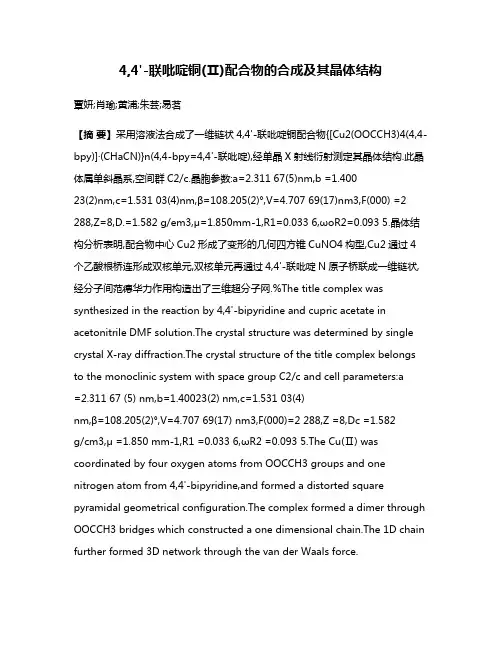
4,4'-联吡啶铜(Ⅱ)配合物的合成及其晶体结构覃妍;肖瑜;黄浦;朱芸;易茗【摘要】采用溶液法合成了一维链状4,4'-联吡啶铜配合物{[Cu2(OOCCH3)4(4,4-bpy)]·(CHaCN)}n(4,4-bpy=4,4'-联吡啶),经单晶X射线衍射测定其晶体结构.此晶体属单斜晶系,空间群C2/c.晶胞参数:a=2.311 67(5)nm,b =1.40023(2)nm,c=1.531 03(4)nm,β=108.205(2)°,V=4.707 69(17)nm3,F(000) =2 288,Z=8,D.=1.582 g/em3,μ=1.850mm-1,R1=0.033 6,ωoR2=0.093 5.晶体结构分析表明,配合物中心Cu2形成了变形的几何四方锥CuNO4构型,Cu2通过4个乙酸根桥连形成双核单元,双核单元再通过4,4'-联吡啶N原子桥联成一维链状,经分子间范德华力作用构造出了三维超分子网.%The title complex was synthesized in the reaction by 4,4'-bipyridine and cupric acetate in acetonitrile DMF solution.The crystal structure was determined by single crystal X-ray diffraction.The crystal structure of the title complex belongs to the monoclinic system with space group C2/c and cell parameters:a=2.311 67 (5) nm,b=1.40023(2) nm,c=1.531 03(4)nm,β=108.205(2)°,V=4.707 69(17) nm3,F(000)=2 288,Z =8,Dc =1.582g/cm3,μ =1.850 mm-1,R1 =0.033 6,ωR2 =0.093 5.The Cu(Ⅱ) was coordinated by four oxygen atoms from OOCCH3 groups and one nitrogen atom from 4,4'-bipyridine,and formed a distorted square pyramidal geometrical configuration.The complex formed a dimer through OOCCH3 bridges which constructed a one dimensional chain.The 1D chain further formed 3D network through the van der Waals force.【期刊名称】《桂林理工大学学报》【年(卷),期】2016(036)004【总页数】5页(P799-803)【关键词】4,4'-联吡啶;铜配合物;晶体结构【作者】覃妍;肖瑜;黄浦;朱芸;易茗【作者单位】桂林理工大学广西岩溶地区水污染控制与用水安全保障协同创新中心,广西桂林541004;桂林理工大学广西岩溶地区水污染控制与用水安全保障协同创新中心,广西桂林541004;桂林理工大学广西岩溶地区水污染控制与用水安全保障协同创新中心,广西桂林541004;桂林理工大学广西岩溶地区水污染控制与用水安全保障协同创新中心,广西桂林541004;桂林理工大学广西岩溶地区水污染控制与用水安全保障协同创新中心,广西桂林541004【正文语种】中文【中图分类】O614.12配位聚合物通常是指金属离子和小分子配体通过自组装形成的、具有高度规整的无限网络结构的配合物[1]。

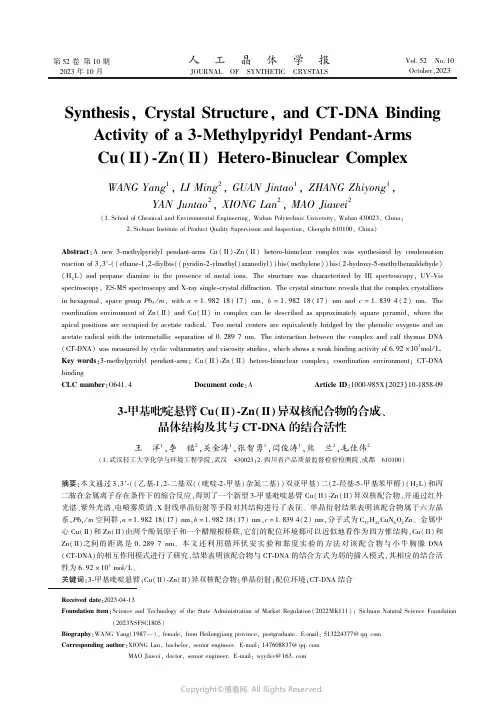
第52卷第10期2023年10月人㊀工㊀晶㊀体㊀学㊀报JOURNAL OF SYNTHETIC CRYSTALSVol.52㊀No.10October,2023Synthesis,Crystal Structure,and CT-DNA Binding Activity of a3-Methylpyridyl Pendant-ArmsCu(II)-Zn(II)Hetero-Binuclear ComplexWANG Yang1,LI Ming2,GUAN Jintao1,ZHANG Zhiyong1,YAN Juntao2,XIONG Lan2,MAO Jiawei2(1.School of Chemical and Environmental Engineering,Wuhan Polytechnic University,Wuhan430023,China;2.Sichuan Institute of Product Quality Supervision and Inspection,Chengdu610100,China)Abstract:A new3-methylpyridyl pendant-arms Cu(II)-Zn(II)hetero-binuclear complex was synthesized by condensation reaction of3,3ᶄ-((ethane-1,2-diylbis((pyridin-2-ylmethyl)azanediyl))bis(methylene))bis(2-hydroxy-5-methylbenzaldehyde) (H2L)and propane diamine in the presence of metal ions.The structure was characterized by IR spectroscopy,UV-Vis spectroscopy,ES-MS spectroscopy and X-ray single-crystal diffraction.The crystal structure reveals that the complex crystallizes in hexagonal,space group P63/m,with a=1.98218(17)nm,b=1.98218(17)nm and c=1.8394(2)nm.The coordination environment of Zn(II)and Cu(II)in complex can be described as approximately square pyramid,where the apical positions are occupied by acetate radical.Two metal centers are equivalently bridged by the phenolic oxygens and an acetate radical with the intermetallic separation of0.2897nm.The interaction between the complex and calf thymus DNA (CT-DNA)was measured by cyclic voltammetry and viscosity studies,which shows a weak binding activity of6.92ˑ103mol/L.Key words:3-methylpyridyl pendant-arm;Cu(II)-Zn(II)hetero-binuclear complex;coordination environment;CT-DNA bindingCLC number:O641.4㊀㊀Document code:A㊀㊀Article ID:1000-985X(2023)10-1858-09 3-甲基吡啶悬臂Cu(II)-Zn(II)异双核配合物的合成㊁晶体结构及其与CT-DNA的结合活性王㊀洋1,李㊀铭2,关金涛1,张智勇1,闫俊涛1,熊㊀兰2,毛佳伟2(1.武汉轻工大学化学与环境工程学院,武汉㊀430023;2.四川省产品质量监督检验检测院,成都㊀610100)摘要:本文通过3,3ᶄ-((乙基-1,2-二基双((吡啶-2-甲基)杂氮二基))双亚甲基)二(2-羟基-5-甲基苯甲醛)(H2L)和丙二胺在金属离子存在条件下的缩合反应,得到了一个新型3-甲基吡啶悬臂Cu(II)-Zn(II)异双核配合物,并通过红外光谱㊁紫外光谱㊁电喷雾质谱㊁X射线单晶衍射等手段对其结构进行了表征㊂单晶衍射结果表明该配合物属于六方晶系,P63/m空间群,a=1.98218(17)nm,b=1.98218(17)nm,c=1.8394(2)nm,分子式为C37H41CuN6O4Zn㊂金属中心Cu(II)和Zn(II)由两个酚氧原子和一个醋酸根桥联,它们的配位环境都可以近似地看作为四方锥结构,Cu(II)和Zn(II)之间的距离是0.2897nm㊂本文还利用循环伏安实验和黏度实验的方法对该配合物与小牛胸腺DNA (CT-DNA)的相互作用模式进行了研究,结果表明该配合物与CT-DNA的结合方式为弱的插入模式,其相应的结合活性为6.92ˑ103mol/L㊂关键词:3-甲基吡啶悬臂;Cu(II)-Zn(II)异双核配合物;单晶衍射;配位环境;CT-DNA结合㊀㊀Received date:2023-04-13㊀㊀Foundation item:Science and Technology of the State Administration of Market Regulation(2022MK111);Sichuan Natural Science Foundation (2023NSFSC1805)㊀㊀Biography:WANG Yang(1987 ),female,from Heilongjiang province,postgraduate.E-mail:513224377@㊀㊀Corresponding author:XIONG Lan,bachelor,senior engineer.E-mail:147608837@MAO Jiawei,doctor,senior engineer.E-mail:wyydcc@㊀第10期WANG Yang et al:Syntheses,Crystal Structure,and CT-DNA Binding Activity of a 3-Methylpyridyl Pendant-arms Cu(II)-Zn(II)Hetero-Binuclear Complex1859㊀0㊀IntroductionOver the years,Schiff base complexes have received wide attention for their easy preparation and structural variety,and many of them have been synthesized[1-6].Schiff base complexes are considered to be one type of the most important stereochemical models in transition metal coordination chemistry.Diamines with different branch or pendant-arms are usually selected to synthesize polynitrogen Schiff base macrocyclic complexes with different metal cavity sizes,hoping to achieve similar structure of metalloenzymes and metalloproteins.Pan et al[7].have obtained a series of28-memebered Schiff base macrocyclic complexes with two2-thiophenoethyl pendant-arms using diethylene triamine,which shows good DNA cleavage and antibacterial activities against E.coli.Kou et al[8-9]. have acquired two28-memebered schiff base benzyl pendant-arms macrocyclic complexes with1,3-propanediamine,which reveals an efficient catalytic activity of phosphoester bond cleavage.A lot of macrocyclic binuclear transitional metal complexes owning DNA binding activities,and it's important in further study of DNA structural probes,phosphatase mimics,sequence-specific cleaving agents and potential anticancer drugs.So,the investigation of interaction between calf thymus DNA(CT-DNA)and transition metal complex is an important and active research area[10-11].Cu(II)and Zn(II)play a critical role in diverse biological processes in organisms.In previous work,we reported an unsymmetrical2-methylpyridyl macrocyclic with heterobinuclear Zn(II)Ni(II)complex[12],which shows good binding activity to CT-DNA and cleavage to pBR322 DNA.In order to further clarify the influence of pendant-arms in the complex during DNA binding process,a new Cu(II)Zn(II)heterobinuclear macrocyclic complex bearing two3-methylpyridyl pendant-arms was prepared, shown in Fig.1.The interaction between complex and CT-DNA was investigated by cyclic voltammetry and viscosity studies.Fig.1㊀Synthetic route of complex1㊀Expertimental section1.1㊀Materials and instrumentsThe chemicals such as5-methylbenzaldehyde,3-pyridinecarboxaldehyde,propane diamine,ethanediamine and triethylamine are of analytical grade,and used as purchased.The high-purity solvents such as ethanol,acetonitrile and tetrahydrofuran(THF)are obtained from Sigma.Tetra(nbutyl)ammonium perchlorate(TBAP)was redistilled three times and then dried in a vacuum before use.3-(Bromomethyl)-2-hydroxy-5-methylbenzaldehyde was prepared according to the literature methods[13].The crystal structure of H2L and complex were carried out on a Bruker AXS SMART diffractometer using graphite monochromatized Mo-Kradiation(Mo Kαradiation monochromator).Data reduction and cell refinement were reported by SMART and SAINT programs.The structure was solved by direct methods(Bruker SHELXTL) and refined on F2by the full-matrix least-squares method[14].Hydrogen atoms were located geometrically and refined in riding mode.The non-H atoms were refined with anisotropic displacement parameters.Calculations were1860㊀研究论文人工晶体学报㊀㊀㊀㊀㊀㊀第52卷performed using the SHELX-97crystallographic software package.IR spectra was recorded using KBr disc by a vector22FT-IR spectrophotometer.UV-Vis spectra was recorded on an UV-2450spectrophotometer.The contents of carbon,hydrogen,and nitrogen element were determined on a PerkinElmer240element automatic analyzer.ESMS spectra was recorded on a Finnigan LCQ ESMS mass spectrograph using methanol as the mobile phase with an approximate concentration of1.0mmol㊃L-1.Cyclic voltammograms were run on a CHI model750B electrochemical analyze with a three-electrode cell,which was equipped with a glassy carbon-working electrode,a platinum wire as the counter electrode and an Ag/AgCl electrode as the reference electrode.Viscosity experiments were performed on an Ubbelohde viscometer.1.2㊀Synthesis of the complex1.2.1㊀Synthesis of N1,N2-bis(pyridin-3-ylmethyl)ethane-1,2-diamineTo an ethanol(20mL)solution of3-pyridinecarboxaldehyde(10.8g,0.1mol),a solution of ethanediamine (3.0g,0.05mol)in ethanol(20mL)was added dropwise.magnetic stirred for10h at room temperature,and white solid was formed.Solid mass was separated from the reaction solution and dissolved in50mL methanol, followed by reduction with NaBH4(7.5g,0.2mol)[15].Light yellow,oily liquid was obtained.Yield:10.94g (88.4%).1H NMR(300MHz,CDCl3)δ8.62-8.41(4H,m,Py-H),7.66(2H,d,Py-H),7.38-7.17 (2H,m,Py-H),3.79(4H,s,CH2),2.76(4H,s,CH2),1.76(2H,s,N-H).1.2.2㊀Synthesis of3,3ᶄ-((ethane-1,2-diylbis((pyridin-2-ylmethyl)azanediyl))bis(methylene))bis(2-hydroxy-5-methylbenzaldehyde)(H2L)3-(Bromomethyl)-2-hydroxy-5-methylbenzaldehyde(5.2g,0.022mol)was dissolved in30mL THF,N1, N2-bis(pyridin-3-ylmethyl)ethane-1,2-diamine(2.5g,0.01mol)and triethylamine(4.2g,0.04mol)as dried by potassium hydroxide was added under magnetic stirring.The mixture was stirred at room temperature for24h, then removed the solvent by spinning evaporator.The remaining yellow oil was recrystallized in acetonitrile,yield white solid.Yield:3.6g(66.8%).Some of the white solid dissolved in acetonitrile,light yellow cubic crystals suitable for the X-ray measurement were obtained.1H NMR(300MHz,CDCl3)δ10.19(s,2H,CHO),8.54 (d,J=4.6Hz,2H,Py-H),7.61(d,J=1.1Hz,2H,Py-H),7.37(s,2H,Py-H),7.33-7.07(m,6H, Py-H&Ph-H),3.74(s,4H,Py-CH2),3.66(s,4H,Ph-CH2),2.75(s,4H,NCH2),2.23(s,6H, CH3).13C NMR(75MHz,CDCl3)δ194.33(s),158.44(s),150.59(s),149.08(s),138.00(s),136.92(s), 133.54(s),130.82(s),128.89(s),125.35(s),123.60(s),121.49(s),56.10(s),53.09(s), 50.83(s),20.48(s).1.2.3㊀Synthesis of complex([CuZnL(OAc)])To an ethanol(10mL)solution of H2L(0.135g,0.25mmol),a solution of Cu(OAc)2㊃H2O(0.049g, 0.25mmol)in ethanol(10mL)was added dropwise.The mixture was stirred for2h,a solution of propane diamine(0.019g,0.25mmol)in ethanol(10mL)was added slowly,stirred for another4h.Then a solution of Zn(OAc)2㊃2H2O(0.055g,0.25mmol)was added to above solution and stirred for5h.The suspension turned green and clear.Green block crystals suitable for the X-ray measurement were obtained by evaporation of the solution at room temperature for3weeks.Yield:0.107g(51%).Anal.Calc.for CuZnC37H41N6O4(%):C, 58.27;H,5.42;N,11.02.Found:C,58.21;H,5.50;N,11.02.IR(KBr,cm-1):1622(νC=N),1570, 1427(ν-COO).1.3㊀DNA binding experimentsThe binding activity of the complex towards CT-DNA were analyzed by cyclic voltammetry and viscosity methods.The CT-DNA solution was prepared by dissolving CT-DNA in Tris-HCl buffer(100mL,50mmol/L Tris-HCl,50mmol/L NaCl,pH=7.2).The concentration of CT-DNA solution was determined by employing an extinction coefficient of6600mol/L㊃cm-1at260nm[16].The complex was dissolved in DMF solutions containing㊀第10期WANG Yang et al:Syntheses,Crystal Structure,and CT-DNA Binding Activity of a 3-Methylpyridyl Pendant-arms Cu(II)-Zn(II)Hetero-Binuclear Complex 1861㊀tetra(nbutyl)ammonium perchlorate (TBAP)as the supporting.The solution was deaerated for 15min before measurements.The viscosity studies were carried out using a capillary viscometer at (25.0ʃ0.1)ħ.Each set of data measured in triplicate,averages are presented as (η/η0)1/3versus molar ratio of complex to DNA,where ηis the viscosity of DNA in the presence of the complex and η0is the viscosity of DNA in the absence of complex [17].2㊀Results and discussion 2.1㊀Structural characterization of the complexIR spectrum of the complex shows an intense band characteristic of C N stretching in the 1622cm -1region,which indicates that the Schiff base complex has been formed [18],seen in Fig.2.The bands at 1570,1427cm -1can be assigned to the stretching vibrations of carboxylate.According to the literature,the separation Δν[νas (COO -)-νs (COO -)]in the range of 130~200cm -1suggested COO -coordinate to complex with bidentate bridged mode(νas ,νs :asymmetric and symmetric stretching vibration,respectively)[19].Other bands with weak intensity observed at 598,554and 521,494cm -1can be assigned to vibration of M O and M N,respectively.The IR data is useful in determining the coordination geometry of metal in the N 4O 2coordination site.Fig.2㊀IR spectrum of the complex The UV-Vis spectra of complex shows two sharp absorptions in the range of 300~800nm.The spectral features of the complex is similar to those macrocyclic metal complexes bearing 2-methylpyridyl pendant-arms [20].The sharp absorptions around 258nm region is assigned to π-π∗transition of benzene ring,and the moderate absorptions at 367nm are attributed to the charge transfer(CT)transition of ligand-to-metal.The IR and UV-Vis spectra data of the complexes are in good agreement with their structural features.Fig.3㊀ES-MS spectra of complex (inset the isotopic distribution of the peak at m /z 762.17).(a)Experimental pattern;(b)calculated patternThe ES-MS spectra of the complex in methanol solution was shown in Fig.3.The dominant molecular ion peaks appear at m /z 762.17corresponding to [CuZnL(OAc)]+(calc.762.71),indicating that the cation is1862㊀研究论文人工晶体学报㊀㊀㊀㊀㊀㊀第52卷stable in methanol solution.The results are proved by the good agreement with the theoretical and experiment isotope distributions.Two single crystals of H2L and complex with dimensions of0.16mmˑ0.12mmˑ0.10mm and0.22mmˑ0.24mmˑ0.28mm were selected for X-ray structure analysis.The results indicate that H2L crystallizes in monoclinic,space group C2/c,with a=2.0729(2)nm,b=0.70124(8)nm,c=1.9452(2)nm,while the complex crystallizes in Hexagonal,space group P63/m,with a=1.98218(17)nm,b=1.98218(17)nm, c=1.8394(2)nm.Crystallographic data and details about the data collection of H2L and complex are presented in Table1.Selected bond lengths and angles relevant to the Zn(II)and Cu(II)coordination spheres of the complex are listed in Table2.Table1㊀Crystal data and details of the structure determination for H2L and complexParameter H2L ComplexEmpirical formula C32H34N4O4C37H41CuN6O4ZnFormula weight538.63762.67T/K293293System Monoclinic HexagonalSpace group C2/c P63/ma/nm 2.0729(2) 1.98218(17)b/nm0.70124(8) 1.98218(17)c/nm 1.9452(2) 1.8394(2)α/(ʎ)90.0090.00β/(ʎ)92.249(2)90.00γ/(ʎ)90.00120.00V/nm3 2.8254(5) 6.2588(13)Z46D c/(g㊃cm-3) 1.266 1.214Mu(Mo Kα)/nm0.085 1.125F(000)1144.02376.0Crystal size/mm30.16ˑ0.12ˑ0.100.22ˑ0.24ˑ0.28Mo Kαradiation/Å30.71030.7103θrange/(ʎ) 1.97to26 2.0to25.4N ref,N par2783,1833969,234T min,T max0.987,0.9920.543,0.746S 1.097 1.072R,wR20.0438,0.14030.0444,0.0978CCDC22636002251157Table2㊀Selected bond distances and angles for complexBond Distance/nm Bond Distance/nmCu1 O10.20195(18)Zn1 O10.20228(17)Cu1 O20.1922(3)Zn1 O30.1984(3)Cu1 N20.2104(2)Zn1 N10.2025(2)Bond Angle/(ʎ)Bond Angle/(ʎ)O2 Cu1 O1105.21(8)O3 Zn1 O1103.55(8)O1 Cu1 O1i72.24(10)O1 Zn1 O1i72.10(11)O2 Cu1 N2109.11(8)O3 Zn1 N1103.34(9)O1 Cu1 N290.31(8)O1 Zn1 N187.77(10)O1i Cu1 N2144.57(9)O1i Zn1 N1149.48(10)N2 Cu1 N2i86.71(14)N1 Zn1 N1i99.80(15) The perspective view of H2L and complex are given in Fig.4.The formula of H2L is C32H34N4O4,the basal phenyl plane and pyridyl plane are approximately vertical.The molecular structure of the complex contains a heterodinuclear[CuZnL]2+cation and an OAc-anion,which is rotational symmetry along the Cu-Zn axis.The㊀第10期WANG Yang et al:Syntheses,Crystal Structure,and CT-DNA Binding Activity of a 3-Methylpyridyl Pendant-arms Cu(II)-Zn(II)Hetero-Binuclear Complex 1863㊀complex is a 19-membered [1+1]Schiff-base macrocycle,with two metal ions bridged by two 2-phenoxy oxygens and one acetate.The two 3-methylpyridyl pendant-arms of the complex are situated in the same sidepiece of the mean molecular plane,different from the reported 3-pyridyl pendant-arms binuclear Ni(II)complex,probably due to the distinctive synthetic route [21].The Zn(II)center coordinated with O and N atoms belonging to ligand (O1,N1)and acetate (O3)yield an overall metal coordination geometry of five froming three six-membered chelate rings.(ring 1:Zn1-O1-C1-C2-C7-N1;ring 2:Zn1-N1-C17-C18-C17-N1;ring 3:Zn1-N1-C7-C2-C1-O1).The Cu(II)center bounds by O1,N2and O2,forming two same six-membered chelate rings (Cu1-O1-C1-C6-C9-N2)and a five-membered chelate ring (Cu1-N2-C16-C16-N2).The average distances of Zn (II)or Cu (II)ions deviating from the coordination plane of the respective N 2O 2composition are 0.0470nm and 0.0613nm,respectively.The coordination geometry of Zn (II )and Cu (II )may be considered as approximately square pyramid.The Zn Cu distance is 0.2897nm,which is smaller than the dinickel(II)macrocyclic complex with 2-thiophenoethyl pendant-arms [7].The distance of Cu(II)or Zn(II)ions and corresponding coordination atoms are within 0.2020~0.2104and 0.1984~0.2025nm,respectively.The angle between the two pyridine rings is 25.4ʎ.Fig.4㊀Perspective view of H 2L (a)and complex (b)together with the atom numbering schemesThe cyclic voltammograms of the complex were recorded in DMF solution in the scan range of -1.2~-0.4V.The scan rates were varied in the range of 50~200mV㊃s -1,shown in Fig.5.A pair of redox peak was found at every experimental scan rate,which is considered as Cu(II)Zn(II)/Cu(I)Zn(II)redox couple.For the scan rate of 100mV㊃s -1,the anodic peak potential (E pa )and the cathodic peak potential (E pc )are -0.617and -0.812V,respectively.Half-wave potentials,E 1/2,taken as the average of E pa and E pc ,is -0.715V,which is 0.046V higher than that of E 1/2in 2-methylpyridyl pendant-arms Zn(II)Ni(II)complex [2].The difference of E 1/2may be from the different solution composition in the experiments and the coordination environment around metal ions.The separation of the anodic and cathodic peak potentials(ΔE p )is 0.195V,and the current intensity of cathodic and anodic peaks are nonequivalent(i pc /i pa =2.6),suggesting it s a quasi-reversible electrochemical process [22].The separation of i pc /υ1/2values in the scan rates of 50~200mV㊃s -1is slightly (<0.001),indicative of diffusioncontrolled.Fig.5㊀Cyclic voltammograms of the complex in DMF solution1864㊀研究论文人工晶体学报㊀㊀㊀㊀㊀㊀第52卷2.2㊀DNA binding activityAt present,the electrochemical study of complex and DNA includes cyclic voltammetry,DC polometry,linear scanning voltammetry,etc.Among these methods,the cyclic voltammetry is used the most extensive and advantaged[23].The complex solution interacts with DNA may change redox performance of the cyclic voltammetric curve evidently.Accompany with the presence of DNA,the peak current of the complex shifts positive,indicating that the complex binds with DNA in intercalation mode;the peak current of the complex shifts negative,means the interaction between complex and DNA is grooving or electrostatic interaction[12].The cyclic voltammograms of the complex in Tris-HCl buffer(100mL,50mmol/L Tris-HCl,50mmol/L NaCl,pH=7.2)at a scan of100mV/s are shown in Fig.6.Upon the addition of100μL DNA,it exhibits a pair of anodic and cathodic peaks at-0.789and-0.550V,which can be attributed to the Cu(II)/Cu(I)redox couple[2].The single reduction peak at1.148V is caused by strong electron-donor capacity of the pyridyl arms in complex,which bind to CT-DNA and lead to electronic transfer.Meanwhile,E pa was shifted by0.019V toward anode and i pa was dropped by4.53%,the minor changes compare to the other complexes indicate the present complex bind to CT-DNA through weak intercalation[24].The following equation[25]was applied to further testify the binding affinity of complex to CT-DNA.E0b-E0f=0.059lg(K red/K ox)(1) where E0f and E0b are the formal potentials of the couple in the free and bound forms,K red and K ox are the reduction and oxidize binding constant respectively.The binding constant was calculated according to the equation1/[DNA]=K(1-A)/[1-(i/i0)]-K(2) where[DNA]is the concentration of DNA,K is the binding constant,i and i0are the peak currents with andwithout DNA,A is the proportionality constant.Fig.6㊀Cyclic voltammograms of the complex in theabsence(1)and increasing amount(2~5)ofDNAFig.7㊀Plot of1/[DNA]versus1/(1-i/i0)According to the calculation,a ratio of K red/K ox was calculated as2.4,which indicates the reduced form of the complex bind to DNA is2.4times stronger than the oxidized form.Through the plot of1/[DNA]versus1/(1-i/i0) (see Fig.7),the value of K is6.92ˑ103L㊃mol-1,which is accord with intercalation mode.The K value reveals the CT-DNA binding activity of the complex is weaker compare to the2-methylpyridyl Zn(II)Ni(II)complex. The viscosity method is one of the most direct and effective methods to study the interaction of complex with DNA[26].When the complex binds to the DNA in the interaction mode,the double helix structure of DNA is opened and DNA chain becomes longer,which resulted in the viscosity of DNA solution increases[27].The effect of the H2L and its Cu(II)Zn(II)complex on the viscosity of CT-DNA are shown in Fig.8.With the addition of increasing amounts of H2L or complex,CT-DNA viscosity increases slightly.The results indicate that the binding mode of the complex with CT-DNA is weak intercalation,which is according with the cyclic voltammogram studies. The CT-DNA binding activity of2-methylpyridyl macrocyclic Zn(II)Ni(II)complex is notable higher than the㊀第10期WANG Yang et al:Syntheses,Crystal Structure,and CT-DNA Binding Activity of a 3-Methylpyridyl Pendant-arms Cu(II)-Zn(II)Hetero-Binuclear Complex1865㊀present3-methylpyridyl complex,maybe the reason of different metal coordination environment.Fig.8㊀Effects of increasing amounts of H2L(1)and complex(2)on the relative viscosities ofCT-DNA at(25.0ʃ0.1)ħ;[DNA]=200μmol/L3㊀ConclusionsIn summary,H2L and its Cu(II)Zn(II)complex were synthesized and structurally characterized.The X-ray diffraction results indicate that H2L and its Cu(II)Zn(II)complex crystallizes in different crystal systems and space group.The CT-DNA binding experiments were carried out through cyclic voltammetry and viscosity studies, which suggest that the complex bind to CT-DNA in a weak intercalation mode.The binding activity of the reported 2-pyridylmethyl macrocyclic complex is evidently higher than the present3-pyridylmethyl complex,maybe caused by different metal coordination environment.References[1]㊀ZHANG S,TANG J M,ZHANG J,et al.In situ ligand formation in the synthetic processes from mononuclear Dy(III)compounds to binuclearDy(III)compounds:synthesis,structure,magnetic behavior,and theoretical analysis[J].Inorganic Chemistry,2021,60(2):816-830.[2]㊀MAO J W,ZHOU H,CHEN Y F,et al.Synthesis,structure,DNA interaction,and hydrolytic function toward bis(p-nitrophenyl)phosphate ofa heterobinuclear macrocyclic complex[J].Transition Metal Chemistry,2012,37(4):385-391.[3]㊀SUN G C,HE Z H,LI Z J,et al.Facile synthesis of1,6-bis(2-furyl)-2,5-bis(2-hydroxy-3-formyl-5-methylbenzyl)-2,5-diazahexane:a newdinucleating ligand[J].Molecules,2001,6(12):1001-1005.[4]㊀JABBARI A,NIKOORAZM M,MORADI P.A V(O)-Schiff-base complex on MCM-41as an efficient,reusable,and chemoselectivenanocatalyst for the oxidative coupling of thiols and oxidation of sulfides[J].Research on Chemical Intermediates,2023,49(4):1485-1505.[5]㊀SAGHATFOROUSH L,MOEINI K,HOSSEINI-YAZDI S A,et al.Effective anticancer activities of an acyclic symmetrical compartmental Schiffbase ligand and its Co(II),Cu(II)and Zn(II)complexes against the human leukemia cell line K562[J].Polyhedron,2019,170:312-324.[6]㊀JOSEPH J,RANI G A.Antioxidant and biochemical activities of mixed ligand complexes[J].Applied Biochemistry and Biotechnology,2014,172(2):867-890.[7]㊀PAN Z Q,DING K,ZHOU H,et al.Syntheses,structures and properties of dinickel(II)macrocyclic complexes with two2-thiophenoethylpendant arms[J].Polyhedron,2011,30(13):2268-2274.[8]㊀KOU H Z,WANG Y,DING P P,et al.Synthesis,crystal structure,phosphate hydrolysis activity and antibacterial activity of macrocyclicdinuclear Zn(II)complex with benzyl pendant-arms[J].Journal of Molecular Structure,2020,1216:128299.[9]㊀KOU H Z,WANG Y,DING P P,et al.A new macrocyclic heterobinuclear Cu(II)-Zn(II)complex:synthesis,crystal structure,phosphatehydrolysis,and DNA binding studies[J].Journal of Coordination Chemistry,2019,72(10):1683-1696.[10]㊀ANBU S,KANDASWAMY M,KAMALRAJ S,et al.Phosphatase-like activity,DNA binding,DNA hydrolysis,anticancer and lactatedehydrogenase inhibition activity promoting by a new bis-phenanthroline dicopper(ii)complex[J].Dalton Transactions,2011,40(28):7310-7318.[11]㊀PENG B,GAO Z T,LI X B,et al.DNA binding,DNA cleavage and HSA interaction of several metal complexes containing N-(2-hydroxyethyl)-N -benzoylthiourea and1,10-phenanthroline ligands[J].JBIC Journal of Biological Inorganic Chemistry,2016,21(7): 903-916.[12]㊀丁佩佩,李㊀铭,吴㊀宇,等.一种带吡啶悬臂大环异双核Zn(Ⅱ)-Ni(Ⅱ)配合物的合成㊁晶体结构及其DNA结合/切割性质[J].无1866㊀研究论文人工晶体学报㊀㊀㊀㊀㊀㊀第52卷机化学学报,2022,38(9):1853-1861.DING P P,LI M,Wu Y,et al.Synthesis,crystal structure,and DNA binding/cleavage properties of a macrocyclic heterobinuclear Zn(Ⅱ)-Ni (Ⅱ)complex with pyridylmethyl pendant-arms[J].Chinese Journal of Inorganic Chemistry,2022,38(9):1853-1861(in Chinese). [13]㊀WANG Q,WILSON C,BLAKE A J,et al.The one-pot halomethylation of5-substituted salicylaldehydes as convenient precursors for thepreparation of heteroditopic ligands for the binding of metal salts[J].Tetrahedron Letters,2006,47(50):8983-8987.[14]㊀Smart.Area detector control and integration software,Siemens analytical X-Ray systems[M].Madison:Saint,Inc,1996.[15]㊀HUREAU C,BLONDIN G,CHARLOT M F,et al.Synthesis,structure,and characterization of new mononuclear Mn(II)complexes.electrochemical conversion into new oxo-bridged Mn2(III,IV)complexes.Role of chloride ions[J].Inorganic Chemistry,2005,44(10): 3669-3683.[16]㊀AZAB H A,AL-DEYAB S S,ANWAR Z M,et al.Coordination tendency of N-acetylamino acids,nucleotides,and DNA toward the luminescentbioprobes Tb(III)-bathophenanthroline or Tb(III)-anthracene-9-carboxylic acid[J].Journal of Chemical&Engineering Data,2011,56(12): 4604-4622.[17]㊀TAN C P,LIU J,CHEN L M,et al.Synthesis,structural characteristics,DNA binding properties and cytotoxicity studies of a series of Ru(III)complexes[J].Journal of Inorganic Biochemistry,2008,102(8):1644-1653.[18]㊀FIRMO R N,DE SOUZA I C A,DA SILVA MIRANDA F,et al.A new ligand H4Lox and its iron(III)complex as a platform for thedevelopment of heterotrimetallic complexes[J].Polyhedron,2016,117:604-611.[19]㊀LACHKAR M,GUILARD R,ATMANI A,et al.Synthesis of new binucleating cylindrical macrotricyclic ligands where two cyclam rings are in aface-to-face conformation.Characterization of their dicopper(II)and dinickel(II)complexes[J].Inorganic Chemistry,1998,37(7): 1575-1584.[20]㊀CHEN Y F,SONG H T,MAO J W,et al.Design and synthesis of two macrocyclic dinuclear copper(II)complexes with reversible binding ofnitric oxide[J].Inorganic Chemistry Communications,2013,27:131-137.[21]㊀CHENG Q R,CHEN J Z,ZHOU H,et al.Syntheses,crystal structures,and properties of two macrocyclic dinuclear Ni(II)complexes bearing2-pyridylmethyl pendant-arms[J].Journal of Coordination Chemistry,2011,64(7):1139-1152.[22]㊀SAKTHIVEL A,RAMAN N,MITU L.DNA interaction studies of pyrazolone-and diimine-incorporated Mn(II),Co(II),Ni(II),Cu(II),andZn(II)complexes:synthesis,spectroscopic characterization,and antimicrobial study[J].Monatshefte Für Chemie-Chemical Monthly,2013, 144(5):605-620.[23]㊀MAHADEVAN S,PALANIANDAVAR M.Spectroscopic and voltammetric studies of copper(II)complexes of bis(pyrid-2-yl)-di/trithia ligandsbound to calf thymus DNA[J].Inorganica Chimica Acta,1997,254(2):291-302.[24]㊀WANG Y,XIAO W,MAO J W,et al.Phosphate ester hydrolysis and DNA binding capacity of two new dinuclear Ni(II)complexes[J].Journalof Molecular Structure,2013,1036:361-371.[25]㊀SHAH A,ZAHEER M,QURESHI R,et al.Voltammetric and spectroscopic investigations of4-nitrophenylferrocene interacting with DNA[J].Spectrochimica Acta Part A:Molecular and Biomolecular Spectroscopy,2010,75(3):1082-1087.[26]㊀GURUMOORTHY P,MAHENDIRAN D,PRABHU D,et al.Mixed-ligand copper(II)phenolate complexes:synthesis,spectralcharacterization,phosphate-hydrolysis,antioxidant,DNA interaction and cytotoxic studies[J].Journal of Molecular Structure,2015,1080:88-98.[27]㊀WU H L,JIA F,KOU F,et al.A Schiff base ligand N-(2-hydroxylacetophenone)-3-oxapentane-1,5-diamine and its nickel(II)complex:synthesis,crystal structure,antioxidation,and DNA-binding properties[J].Transition Metal Chemistry,2011,36(8):847-853.。
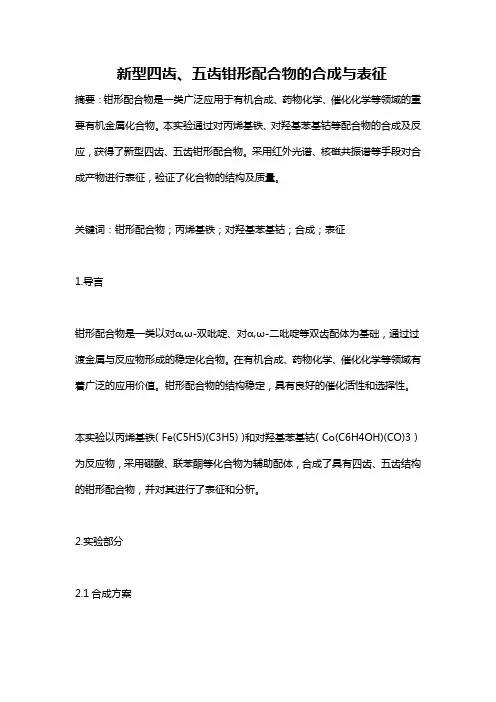
新型四齿、五齿钳形配合物的合成与表征摘要:钳形配合物是一类广泛应用于有机合成、药物化学、催化化学等领域的重要有机金属化合物。
本实验通过对丙烯基铁、对羟基苯基钴等配合物的合成及反应,获得了新型四齿、五齿钳形配合物。
采用红外光谱、核磁共振谱等手段对合成产物进行表征,验证了化合物的结构及质量。
关键词:钳形配合物;丙烯基铁;对羟基苯基钴;合成;表征1.导言钳形配合物是一类以对α,ω-双吡啶、对α,ω-二吡啶等双齿配体为基础,通过过渡金属与反应物形成的稳定化合物。
在有机合成、药物化学、催化化学等领域有着广泛的应用价值。
钳形配合物的结构稳定,具有良好的催化活性和选择性。
本实验以丙烯基铁(Fe(C5H5)(C3H5))和对羟基苯基钴(Co(C6H4OH)(CO)3)为反应物,采用硼酸、联苯酮等化合物为辅助配体,合成了具有四齿、五齿结构的钳形配合物,并对其进行了表征和分析。
2.实验部分2.1合成方案实验中采用丙烯基铁和对羟基苯基钴作为反应物,硼酸和联苯酮等化合物作为辅助配体,通过反应生成钳形配合物。
具体步骤如下:(1)在低温下将丙烯基铁与硼酸反应,得到四齿配体Fe(C5H5)(C3H5)(H2Bc);(2)再将对羟基苯基钴和联苯酮反应,生成五齿配体Co(C6H4OH)(CO)3(H2L);(3)将两种配体分别与乙醇混合,温和搅拌,得到四齿、五齿钳形配合物Fe(H2Bc)2和Co(H2L)(H2Bc)2。
2.2仪器与试剂仪器:红外光谱仪、核磁共振仪;试剂:丙烯基铁、对羟基苯基钴、硼酸、联苯酮、氯仿、CDCl3等。
2.3实验过程(1)合成四齿配体Fe(C5H5)(C3H5)(H2Bc)将1.0g丙烯基铁、0.5g硼酸和3ml的氯仿混合,在0℃下缓慢滴加氢氧化钠溶液(1.0mol/L,6ml),反应后加入乙酸过量中和,然后过滤一次,用乙酸乙酯洗涤,得到Fe(C5H5)(C3H5)(H2Bc)。
(2)合成五齿配体Co(C6H4OH)(CO)3(H2L)将0.5g对羟基苯基钴、0.5g联苯酮和2ml氯仿混合,加入10ml甲醇和0.5ml 盐酸,搅拌30min,反应后过滤,用甲醇洗涤,得到Co(C6H4OH)(CO)3(H2L)。
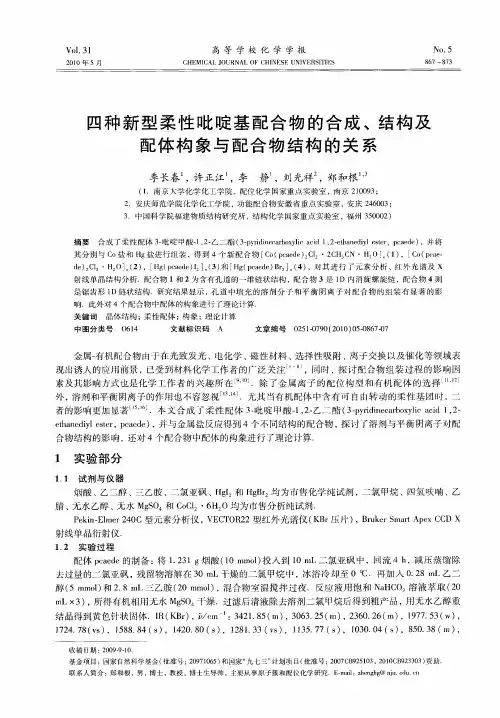
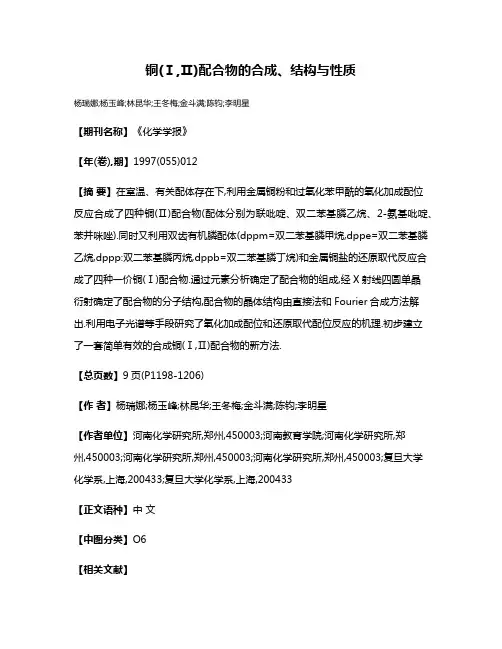
铜(Ⅰ,Ⅱ)配合物的合成、结构与性质杨瑞娜;杨玉峰;林昆华;王冬梅;金斗满;陈钧;李明星【期刊名称】《化学学报》【年(卷),期】1997(055)012【摘要】在室温、有关配体存在下,利用金属铜粉和过氧化苯甲酰的氧化加成配位反应合成了四种铜(Ⅱ)配合物(配体分别为联吡啶、双二苯基膦乙烷、2-氨基吡啶、苯并咪唑).同时又利用双齿有机膦配体(dppm=双二苯基膦甲烷,dppe=双二苯基膦乙烷,dppp:双二苯基膦丙烷,dppb=双二苯基膦丁烷)和金属铜盐的还原取代反应合成了四种一价铜(Ⅰ)配合物.通过元素分析确定了配合物的组成,经X射线四圆单晶衍射确定了配合物的分子结构,配合物的晶体结构由直接法和Fourier合成方法解出.利用电子光谱等手段研究了氧化加成配位和还原取代配位反应的机理.初步建立了一套简单有效的合成铜(Ⅰ,Ⅱ)配合物的新方法.【总页数】9页(P1198-1206)【作者】杨瑞娜;杨玉峰;林昆华;王冬梅;金斗满;陈钧;李明星【作者单位】河南化学研究所,郑州,450003;河南教育学院;河南化学研究所,郑州,450003;河南化学研究所,郑州,450003;河南化学研究所,郑州,450003;复旦大学化学系,上海,200433;复旦大学化学系,上海,200433【正文语种】中文【中图分类】O6【相关文献】1.吡咯甲亚胺镍/铜/锌配合物的合成、荧光性质及镍、铜配合物的晶体结构 [J], 毛盼东;闫玲玲;吴伟娜;宋艺赫;姚必鑫2.由双核铜簇与柔性双三氮唑基配体构筑的一维链状铜配合物的合成、结构与光学性质表征 [J], 杜晓迪;李春阳;常加忠;王振领3.由5-溴间苯二甲酸和2,2'-联吡啶构筑的两个铜(Ⅱ)配合物的合成、晶体结构及磁性质 [J], 黎彧; 邹训重; 冯安生; 赵振宇4.基于3,4-乙撑二氧基噻吩环配体的铜/锌配合物的合成、晶体结构及性质 [J], 韦文厂;刘峥;魏润芝;唐群;梁楚欣;张淑芬5.基于双功能配体2,2′:6′2″-三联吡啶-4′-羧酸的三种铜配合物的合成、结构及性质[J], 贺春雨;杨小青;张雁红;姜爽因版权原因,仅展示原文概要,查看原文内容请购买。
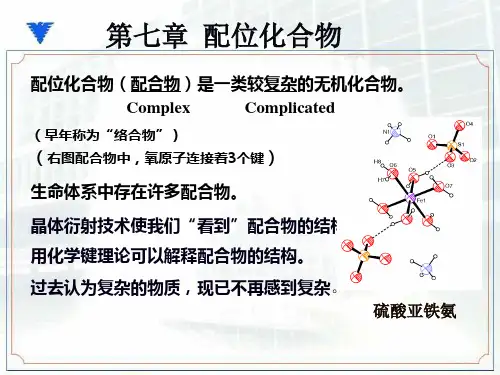
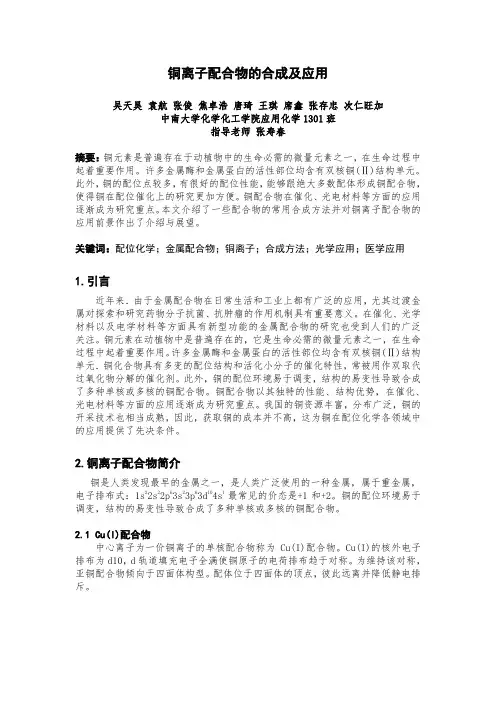
铜离子配合物的合成及应用吴天昊袁航张俊焦卓浩唐琦王琪席鑫张存忠次仁旺加中南大学化学化工学院应用化学1301班指导老师张寿春摘要:铜元素是普遍存在于动植物中的生命必需的微量元素之一,在生命过程中起着重要作用。
许多金属酶和金属蛋白的活性部位均含有双核铜(Ⅱ)结构单元。
此外,铜的配位点较多,有很好的配位性能,能够跟绝大多数配体形成铜配合物,使得铜在配位催化上的研究更加方便。
铜配合物在催化、光电材料等方面的应用逐渐成为研究重点。
本文介绍了一些配合物的常用合成方法并对铜离子配合物的应用前景作出了介绍与展望。
关键词:配位化学;金属配合物;铜离子;合成方法;光学应用;医学应用1.引言近年来.由于金属配合物在日常生活和工业上都有广泛的应用,尤其过渡金属对探索和研究药物分子抗菌、抗肿瘤的作用机制具有重要意义。
在催化、光学材料以及电学材料等方面具有新型功能的金属配合物的研究也受到人们的广泛关注。
铜元素在动植物中是普遍存在的,它是生命必需的微量元素之一,在生命过程中起着重要作用。
许多金属酶和金属蛋白的活性部位均含有双核铜(Ⅱ)结构单元.铜化合物具有多变的配位结构和活化小分子的催化特性,常被用作双取代过氧化物分解的催化剂。
此外,铜的配位环境易于调变,结构的易变性导致合成了多种单核或多核的铜配合物。
铜配合物以其独特的性能、结构优势,在催化、光电材料等方面的应用逐渐成为研究重点。
我国的铜资源丰富,分布广泛,铜的开采技术也相当成熟,因此,获取铜的成本并不高,这为铜在配位化学各领域中的应用提供了先决条件。
2.铜离子配合物简介铜是人类发现最早的金属之一,是人类广泛使用的一种金属,属于重金属,电子排布式:1s22s22p63s23p63d104s1 最常见的价态是+1和+2。
铜的配位环境易于调变,结构的易变性导致合成了多种单核或多核的铜配合物。
2.1 Cu(I)配合物中心离子为一价铜离子的单核配合物称为Cu(I)配合物。
Cu(I)的核外电子排布为d10,d轨道填充电子全满使铜原子的电荷排布趋于对称。
![配合物[Cu(L-Ile)(TATP)(H2O)]ClO4的结构、表征及与DNA之间的相互作用](https://uimg.taocdn.com/d3f88445dcccda38376baf1ffc4ffe473268fd50.webp)
配合物[Cu(L-Ile)(TATP)(H2O)]ClO4的结构、表征及与DNA之间的相互作用宋智君;乐学义;李红;刘彩红;冯小龙【期刊名称】《无机化学学报》【年(卷),期】2005(21)4【摘要】@@ 氨基酸多吡啶铜配合物可以作为酶-金属-底物三元配合物的模型化合物引起了人们的极大兴趣[1-4].最近,又发现该类配合物对DNA有较好的插入或部分插入作用[5~7],因此这类配合物有可能成为新的DNA切割剂或抗癌和抗病菌药物,在医学上有着潜在的应用前景.【总页数】4页(P527-530)【作者】宋智君;乐学义;李红;刘彩红;冯小龙【作者单位】华南农业大学理学院应用化学系,广州,510642;华南农业大学理学院应用化学系,广州,510642;华南师范大学化学系,广州,510631;华南师范大学化学系,广州,510631;中山大学分析测试中心,广州,510275【正文语种】中文【中图分类】O614.121【相关文献】1.镍-多吡啶配合物[Ni(dmbpy)3](H2O)(ClO4)2的合成、晶体结构及与DNA相互作用研究 [J], 张万举;王芳;杨水彬2.新颖双核铜配合物[Cu2(C7H19N3O)2(C10H8N2)](ClO4)4·H2O的合成、晶体结构及表征 [J], 钱保华;许兴友;陆路德;杨绪杰;汪信3.[Cu(L-Ile)(Phen)(H2O)(ClO4)]的合成、结构及稳定性研究 [J], 刘小平;杨迟;乐学义;周晓华;吴玲莹;陈实4.三元配合物[Cu(L-tyr)(TATP)(H2O)]ClO4·H2O的合成、晶体结构及芳环堆积作用 [J], 乐学义;童明良;付银莲;计亮年5.一种双核铜配合物[Cu(Ⅱ)2(Paba)2(4,4'-Bipy)(H2O)2]·(ClO4)2的合成、表征及晶体结构 [J], 欧阳淼;蔡成翔;赵志愿;陈倩倩;蒋毅民因版权原因,仅展示原文概要,查看原文内容请购买。
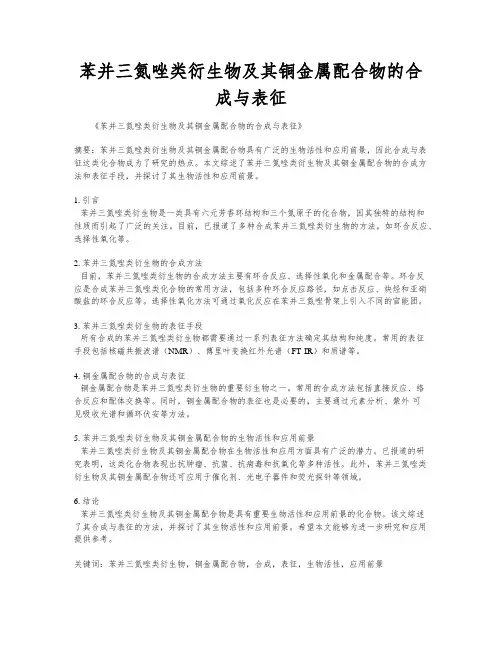
苯并三氮唑类衍生物及其铜金属配合物的合成与表征《苯并三氮唑类衍生物及其铜金属配合物的合成与表征》摘要:苯并三氮唑类衍生物及其铜金属配合物具有广泛的生物活性和应用前景,因此合成与表征这类化合物成为了研究的热点。
本文综述了苯并三氮唑类衍生物及其铜金属配合物的合成方法和表征手段,并探讨了其生物活性和应用前景。
1. 引言苯并三氮唑类衍生物是一类具有六元芳香环结构和三个氮原子的化合物,因其独特的结构和性质而引起了广泛的关注。
目前,已报道了多种合成苯并三氮唑类衍生物的方法,如环合反应、选择性氧化等。
2. 苯并三氮唑类衍生物的合成方法目前,苯并三氮唑类衍生物的合成方法主要有环合反应、选择性氧化和金属配合等。
环合反应是合成苯并三氮唑类化合物的常用方法,包括多种环合反应路径,如点击反应、炔烃和亚硝酸盐的环合反应等。
选择性氧化方法可通过氧化反应在苯并三氮唑骨架上引入不同的官能团。
3. 苯并三氮唑类衍生物的表征手段所有合成的苯并三氮唑类衍生物都需要通过一系列表征方法确定其结构和纯度。
常用的表征手段包括核磁共振波谱(NMR)、傅里叶变换红外光谱(FT-IR)和质谱等。
4. 铜金属配合物的合成与表征铜金属配合物是苯并三氮唑类衍生物的重要衍生物之一。
常用的合成方法包括直接反应、络合反应和配体交换等。
同时,铜金属配合物的表征也是必要的,主要通过元素分析、紫外-可见吸收光谱和循环伏安等方法。
5. 苯并三氮唑类衍生物及其铜金属配合物的生物活性和应用前景苯并三氮唑类衍生物及其铜金属配合物在生物活性和应用方面具有广泛的潜力。
已报道的研究表明,这类化合物表现出抗肿瘤、抗菌、抗病毒和抗氧化等多种活性。
此外,苯并三氮唑类衍生物及其铜金属配合物还可应用于催化剂、光电子器件和荧光探针等领域。
6. 结论苯并三氮唑类衍生物及其铜金属配合物是具有重要生物活性和应用前景的化合物。
该文综述了其合成与表征的方法,并探讨了其生物活性和应用前景。
希望本文能够为进一步研究和应用提供参考。
二维和三维3d-4f异金属配位聚合物的合成与结构表征张漫波; 郑少九; 肖卓杰; 雷凯斌; 宋丽华; 梁福沛; 胡瑞祥【期刊名称】《《湖南师范大学自然科学学报》》【年(卷),期】2019(042)005【总页数】8页(P65-72)【关键词】镧系元素; 铜; 3d-4f; 吡啶-2;6-二羧酸; 4;4′-联吡啶【作者】张漫波; 郑少九; 肖卓杰; 雷凯斌; 宋丽华; 梁福沛; 胡瑞祥【作者单位】湖南师范大学化学化工学院国家级化学化工实验教学示范中心化学生物学与中药分析教育部重点实验室中国长沙 410081; 广西师范大学化学与药学学院中国桂林 541004; 中国地质调查局沈阳地质调查中心中国沈阳 110032【正文语种】中文【中图分类】O641.4; O614.121稀土离子和过渡金属离子通过有机配体键合配位形成的3d-4f异金属配合物的设计和合成是配位化学领域的研究热点之一。
3d-4f异金属配合物中金属离子种类和数量可变,有机配体配位模式多样,因此可构筑具有不同结构特征和性质的化合物。
3d-4f异金属配合物在超导材料催化[1,2]、吸附[3-5]和磁性材料[6,7]等领域都具有潜在的应用价值。
在合成3d-4f异金属配合物时,合适的有机配体对成功构筑异金属配合物至关重要。
配体种类不同,得到的3d-4f异金属配合物的结构也不同。
文献报道的3d-4f异金属配合物根据结构特征大致可分为低聚物[8,9]、配位聚合物[10-12]和簇合物[13-15]。
稀土离子和过渡金属离子由于电子结构特征上的区别而显现出不同的化学性质,比如稀土离子属于硬酸,容易与氧原子配位,而过渡金属离子则倾向于与氮原子结合。
因此一些含N和O的有机配体,如席夫碱[16,17],氨基酸[18,19],亚氨基二乙酸[20]和芳香族羧酸[21,22]等已被广泛用于构筑配体3d-4f异金属化合物。
其中,席夫碱配体一般用于合成低聚物;氨基酸类配体常用于构筑多核的异金属簇合物;含氮羧酸配体[23,24]如吡啶羧酸类、咪唑羧酸和吡嗪羧酸等有机分子则常用于构筑3d-4f异金属配位聚合物。
吡啶基配体在偶联反应概述说明以及概述1. 引言1.1 概述吡啶基配体作为有机合成化学中重要的功能性单位,在偶联反应中发挥着关键的催化作用。
由于其独特的结构和活性,吡啶基配体已经在多种有机反应中得到广泛应用,并取得了显著的研究进展和实际应用价值。
本文将对吡啶基配体在偶联反应中的应用进行概述,介绍其定义、特点以及作用机制,并归纳总结了吡啶基配体在不同类型偶联反应中的典型应用案例。
1.2 文章结构本文主要分为五个部分。
首先是引言部分,概述了文章的目的和结构。
接下来第二部分将详细介绍吡啶基配体在偶联反应中的应用,包括其定义和特点、作用机制以及不同类型偶联反应中的具体应用案例。
第三部分将回顾吡啶基配体在有机合成中的发展历程,从初期探索与发现到发展与改进过程,并展望当前研究进展以及未来前景。
第四部分将深入讨论吡啶基配体的设计和合成方法,包括研究结构与性质关系的应用、合成方法及其优化策略研究以及新型吡啶基配体的设计与合成案例分析。
最后,第五部分为结论与展望,对本文主要研究结果进行总结,并展望未来在吡啶基配体领域中的潜在研究方向。
1.3 目的本文旨在系统地介绍和探讨吡啶基配体在偶联反应中的应用以及在有机合成中的发展历程。
通过对吡啶基配体相关研究的概述和分析,期望能够全面了解吡啶基配体的特点和作用机制,并揭示其在不同类型偶联反应中的应用案例。
此外,本文还将对吡啶基配体的设计和合成方法进行详细阐述,并展望未来可能出现的研究方向。
通过这些内容的综合讨论与分析,为进一步提高吡啶基配体的催化性能、扩展其应用范围以及推动有机合成反应和纳米材料等领域取得更多创新突破提供借鉴和参考。
2. 吡啶基配体在偶联反应中的应用2.1 吡啶基配体的定义和特点吡啶基配体是一类具有含有吡啶环结构的有机化合物,它们通常被设计用于催化各种偶联反应。
这些配体可以通过选择性地与金属催化剂形成稳定的络合物,从而促进反应进程,并提高反应的效率和选择性。
吡啶作为五元杂环结构,具有良好的稳定性和可调节的电子性质,使其成为理想的配体分子。
《应用化学综合实验》(项目化)无机部分实验指导书
课程代码:0703525008 开课学期:第6学期 开课专业:应用化学
实验学时: 16学时 总学分/实验学分: 0.5学分
综合实验室(实验中心)名称:生化实验中心 二级实验室名称:绿色功能材料与应用实验室
一、课程简介
《应用化学综合实验》无机部分实验是化学专业的一门重要专业综合实验课,它的先修课程
是无机化学和无机化学实验。本课程是在基础无机化学实验技能的基础上,进一步系统全面地提
高无机合成实验技能,为学生的毕业论文打好实验基础,也为从事无机配合物的合成与应用开发
奠定必要的理论和技术基础。
二、实验的地位、作用和目的
通过该实验课程的学习对综合性实验进行全面的了解和掌握。目的:一是通过目标配体配合
物的合成学习一般金属配合物的合成方法和实验条件;二是了解金属配合物的性质测试和表征方
法。
三、实验基本要求
1. 掌握基础有机化学合成技术合成目标配体,并通过核磁共振、红外光谱和紫外光谱对其进
行测定;
2. 掌握金属配合物合成的基本技术和方法,能够利用红外光谱和紫外光谱对其结构信息进行
分析。
四、报告与考核
实验报告包含预习报告、实验报告及结果讨论等内容。
考核:1、实验的方案方法20%;2、实验操作和实验结果40%;3、实验报告和分析讨论40%。
项目简介和要求
含N多吡啶配体具有配位能力强、合成简单等特点,常被用于合成各种金属配合物。本项目
以2-氨甲基吡啶和2-醛基吡啶为起始原料,通过席夫碱反应和硼氢化钠还原,制备得到一个含N
多吡啶配体,将其与便宜易得的铁盐或铜盐反应,合成铁或铜的配合物,并通过红外、紫外光谱
等表征对其结构信息进行分析与确认。
具体合成方案如下:
主要内容如下:
(1)配体二(吡啶-2-甲基)胺 (L1)的合成研究
主要研究反应温度、溶剂、还原剂及反应时间等因素对配体L1合成收率的影响,找出最佳的反
应条件。并对配体L1进行核磁共振、红外及紫外光谱等表征。
(2)铁或铜配合物的合成研究
利用配体L1与铁或铜的氯化盐在适宜的条件下进行反应,通过优化反应溶剂、反应温度、反
应时间及反应物配比等影响因素,制备得到铁配合物M1或铜配合物M2,并通过红外和紫外光谱
测定对其结构信息进行分析和确定。
实验要求:
(1)学会文献查阅和资料整理。
(2)学会如何参考文献设计实验方案,主要包括原料配比、实验具体操作步骤、如何监测判断
反应终点、反应完毕后处理、产品纯化和结构鉴定。
(3)掌握红外、紫外光谱等测试方法,并学会处理分析相关的实验数据,得出正确的实验结果。
多吡啶配体及其铜/铁配合物的合成及表征设计指导书
项目一 多吡啶配体——二(吡啶-2-甲基)胺 (L1)的合成与表征
一、目的要求
1、掌握席夫碱反应的原理和操作技术;
2、熟练掌握利用薄层层析方法判断反应的终点及柱层析分离纯化产物的技术和操作规范;
4、掌握有机配体的一般鉴定方法。
二、实验原理
三、实验原料和试剂
2-氨甲基吡啶、2-醛基吡啶、硼氢化钠、甲醇
四、实验步骤
2-胺甲基吡啶 (0.48 mL, 5.0 mmol) 、吡啶-2-甲醛 (0.54 mL, 5.0 mmol) 加入250 mL的flask中
加入甲醇使其溶解,室温搅拌3小时,称取过量的硼氢化钠 (0.466 g, 12.3 mmol) 在冰浴下加入反应
瓶中,室温下搅拌5~6小时。薄层色谱检测,确定反应结束后,抽干溶剂,加入少量水,用二氯甲
烷萃取。收集有机相,用饱和食盐水洗涤2-3次,加入无水硫酸镁干燥数小时。过滤除去固体硫酸
镁,收集滤液除去溶剂,浓缩至5 mL左右,通过柱色谱 (EA/EtOH/Et3N = 5:1:0.1) 分离得到产物
L1(0.638 g, 54%)。对其进行核磁、红外和紫外光谱表征。
五、注意事项和思考题
1、加入硼氢化钠必须保证低温,最好采用少量多次加入的方式,同时不能将反应瓶密封,确保
产生的气体及时排出(为什么要这样做?)。
2、硼氢化钠的作用是什么?能否用其他类似的试剂代替?
3、柱层析注意事项有哪些?
4、简述柱层析和薄层色谱选择合适淋洗剂的选择。
5、对配体L1的核磁和红外特征峰进行具体的归属。
项目二 含N多吡啶配体配位的铜/铁配合物的合成与表征
一、目的要求
1、掌握配合物合成操作技术;
2、掌握配合物纯化的方法和技术;
3、掌握配合物的一般表征方法。
二、实验原理
三、实验原料和试剂
配体L1、FeCl3·6H2O、CuCl2·2H2O、甲醇
四、方法步骤
将配体L1 (199 mg,1.0 mmol)溶解在甲醇溶剂 (2 mL)中。称取等摩尔量的
FeCl3·6H2O (270 mg,1.0 mmol)均匀的溶解在甲醇溶液 (3 mL)中,在搅拌下将三价铁的
甲醇溶液逐滴加入化合物L1的甲醇溶液中,滴加过程中有大量黄色固体产生,室温下
搅拌反应2h后点板检测化合物L1完全反应。停止反应,置于水泵上抽掉一部分溶剂甲
醇,过滤得到淡黄色固体 (314.5 mg,87%),用乙醚,乙酸乙酯,二氯甲烷洗涤黄色固
体。将其溶解在乙腈中向溶液中慢慢加入乙醚,通过乙醚扩散到乙腈溶液中后得到黄色
晶体。对其进行红外和紫外光谱表征。
铜配合物M2的合成和上述M1的合成步骤一样,仅将原料FeCl3·6H2O换成
CuCl2·2H2O,最后得到蓝色固体M2(303 mg,91%)。对其进行红外和紫外光谱表征。
五、注意事项和思考题
1、如何纯化金属配合物?
2、比较分析配体与配合物的红外和紫外光谱图,对其差别进行解释说明。
3、Fe(III)和Cu(II)的配合物能否通过核磁进行鉴定?为什么?
4、红外和紫外光谱能否准确的鉴定金属配合物的结构?若不能,哪些测试方法可以?